This blog has been written in collaboration with Intoleran
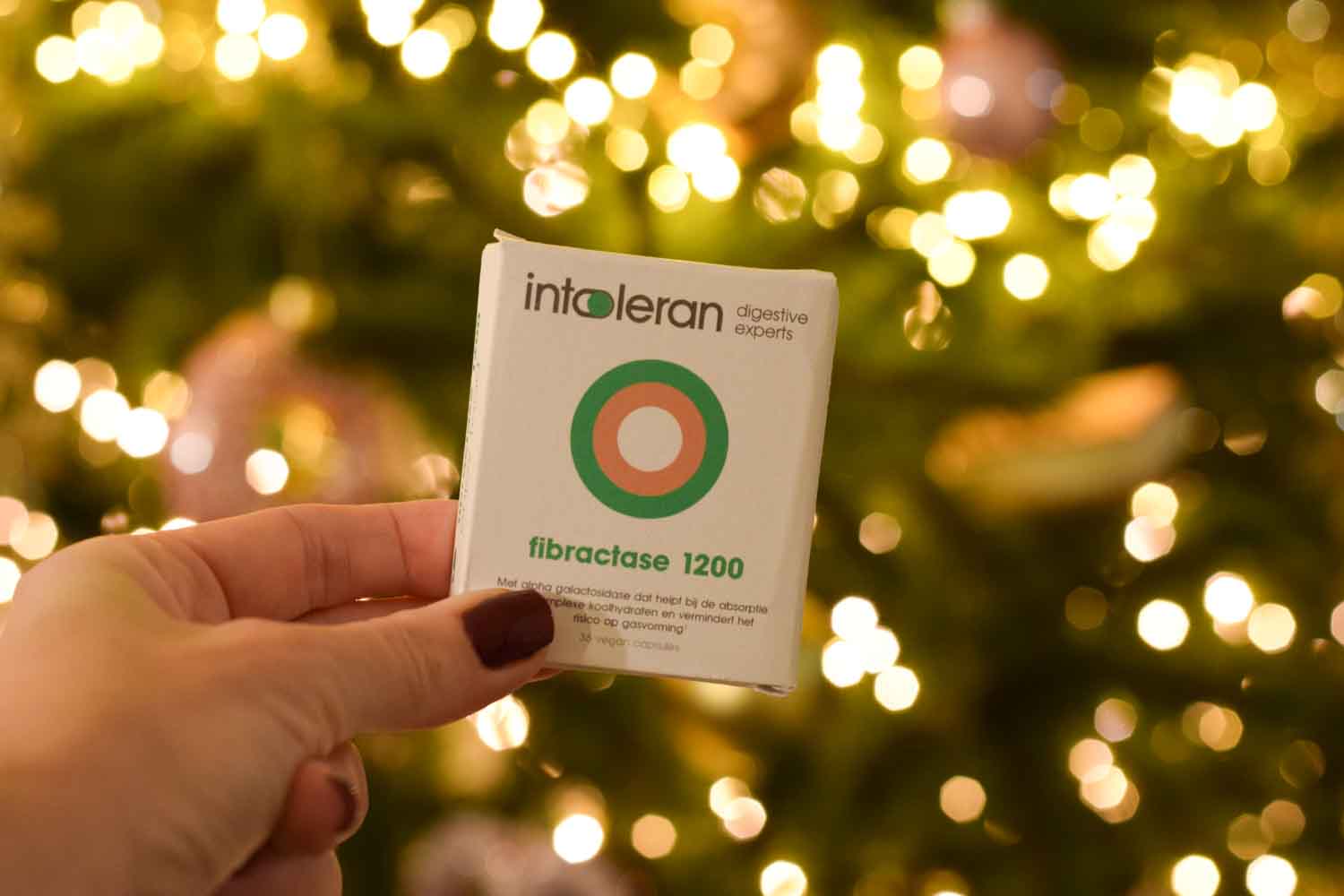
Fructan intolerance and alpha-galactosidase enzymes
Now that the holidays are approaching, there are many dinners, and parties waiting for us. If you have to eat low FODMAP, it can sometimes feel like a challenge.
Almost a quarter of people with IBS who follow a FODMAP diet discover that they react to one or more product groups from the FODMAP group of fructans.
This is also often the most difficult group to deal with when you go out to eat or have a party because fructans include onion and garlic.
And if you avoid that, you will discover that it is added to many dishes.
In this blog, I want to tell you a little more about what fructans are, why many people with IBS suffer from them, and how you can deal with them.
So that you too have relaxed and happy holidays, without too many stomach pains!
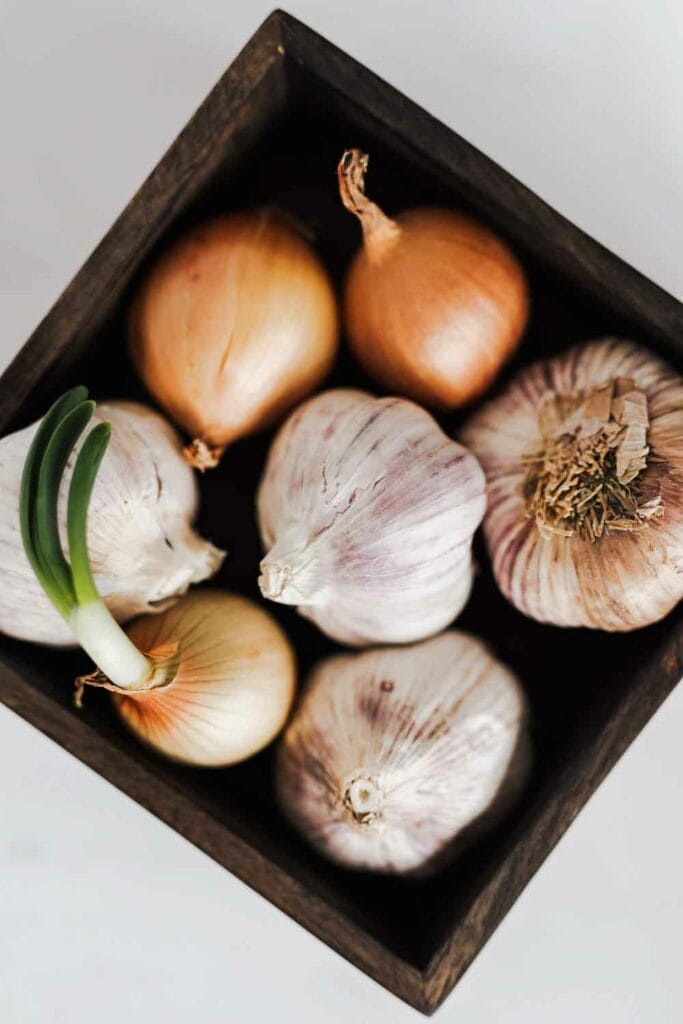
What are fructans?
Fructans are one of the FODMAP groups. This is the group of oligosaccharides, the “O” in the word FODMAP.
Fructans consist of fructose molecules with a glucose molecule at the end. These molecules cannot be broken down properly in the intestines.
Research has shown that most people can only break down 5-15% of fructans.
This is because there are not enough enzymes that can cut the fructans into separate fructose and glucose molecules.
Because they cannot be broken down properly, they travel to the large intestine where they are fermented by the bacteria in your intestines.
This fermentation process creates gases. This also explains why many people suffer from flatulence after eating, for example, a dish with a lot of onion.
Almost no one digests fructans well. But for some people with IBS, this leads to additional complaints.
About 24% of people with IBS are sensitive to fructans and for them, the extra gases in the intestines can cause complaints such as bloating, flatulence, nausea, and/or diarrhea.

Which foods contain fructans?
Products from different food groups contain a large amount of fructans. Fructans are found in several kinds of fruit, vegetables, grains, and legumes.
Some examples are:
- Vegetables: onion, garlic, leek, asparagus and artichokes.
- Fruit: ripe bananas, grapefruit, dates, raisins and other dried fruits
- Grains: wheat bread, breakfast cereals, and other wheat products
- Nuts and legumes: black beans, kidney beans, cashew nuts, pistachios
How do you know if you are intolerant to fructans?
You do this during the FODMAP diet in the reintroduction phase of the diet. After completing the elimination phase, you will reintroduce the different FODMAP groups into your diet one by one.
For the fructan group, you test four different types of products: onion, garlic, vegetables or fruit, and wheat.
You test these separately, because you may not react to wheat, for example, but you do to onions. With these four tests, you get the most complete picture possible of what you can and cannot tolerate.
With testing you not only find out what you respond to, but also to what amount. You always test 3 quantities of a food.
For example, you may not respond to the test amount of 1/8 onion, but you will respond to 1/4 onion. Then you know that you can add a little onion to your meals, but not too much.

Avoiding fructans
For me, everything within the fructan group bothers me. Wheat, onion, and garlic are the main culprits for me.
A very small amount can be okay, but if I eat a little more, I am guaranteed to get complaints.
That’s why I hardly eat any onions or garlic at home and, apart from a few small amounts here and there, I also eat a few wheat products.
I replace these with gluten-free products or spelt products, to which I respond well.
And that is also the advice for people who react to fructans: avoid the amounts you react to in your diet.
If you tolerate a small amount of these foods, be sure to add that amount to your dishes occasionally.
The products that contain fructans are often healthy products that provide good building materials for your body. It’s a shame if you miss out on those.
If you continue to exclude them for an unnecessarily long time, you may also react more strongly to them, and your body is no longer used to these foods.
So eating small amounts if you tolerate them and testing regularly (for example once a year) to ensure that your tolerance level has not yet changed is very valuable.
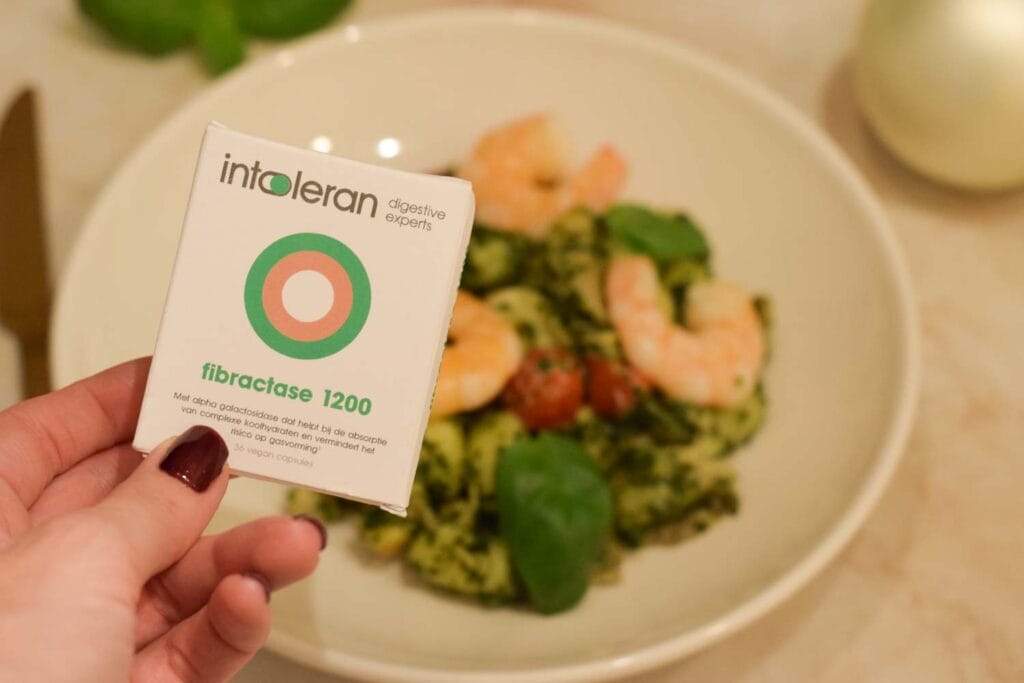
Alpha galactosidase enzyme: Fibractase
Avoiding onions and garlic when eating outside of your own home is quite a challenge. When people ask me what intolerances I have and I mention onion and garlic, I always get a shocked reaction.
You can’t eat garlic and onion?! That’s impossible in a restaurant.
And it’s true, that is quite a challenge. Although I have good experiences eating out.
I usually call the restaurant beforehand and then there is almost always something I can eat.
I also make sure that I always have enzymes with me when I go out to eat.
I really like using Fibractase 1200 from the brand Intoleran.
Fibractase contains the digestive enzyme Alpha Galactosidase. Alpha Galactosidase aids in the digestion of complex carbohydrates found in grains, legumes, and cruciferous vegetables.
This enzyme prevents gas, bloating, indigestion, and diarrhea associated with fructans and galactans intolerance*
I often take Fibractase 1200 when I have doubts about whether a meal contains onion or garlic. For example, because it comes with a sauce.
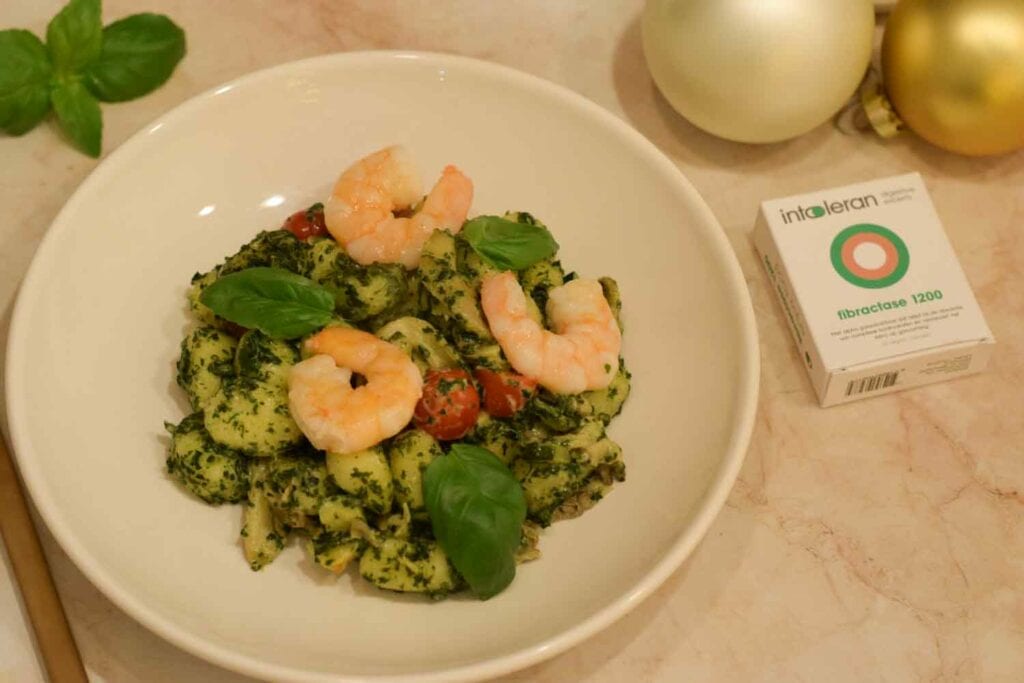
When I take this supplement, I notice that I have fewer complaints.
If I eat onion or garlic without a supplement, I get a lot of bloating and flatulence. And I often suffer from an upset stomach for a few days.
It also sometimes gives me a headache or makes me feel nauseous. If I take Fibractase with it, I hardly have this.
I do notice that when I go out to eat, I often eat a little more than normal. And for me, for example, that causes a bit of a bloated feeling or some flatulence.
But the severe complaints that I normally get from onions and garlic stay away. So that’s nice.
This gives me a lot of freedom and peace of mind when dining out.
I still make sure that I choose my dishes in such a way that they contain as few FODMAPs as possible and I usually also communicate my intolerances beforehand.
But using these supplements makes the choice a little wider and also ensures that I can occasionally enjoy a sauce or dish that I would otherwise not touch without fear.
The Fibractase1200 supplement contains 1200 units of the enzyme Alpha-galactosidase.
You usually order Fibractase 1200 for $44.99 for 36 capsules. Right now, Intoleran has a holiday promotion going on, and now you only pay $38.24 for a package.
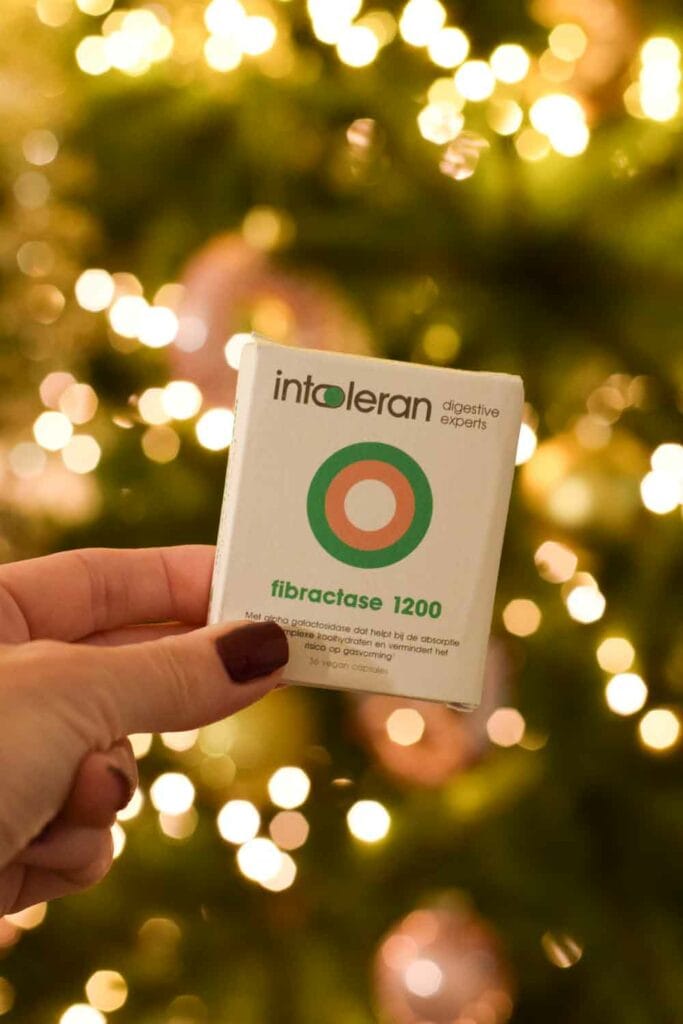
How to use Fibractase?
If you use Fibractase, the alpha-galactosidase enzyme must enter your stomach/intestines at the same time as the food.
So that the enzymes can help digest the complex carbohydrates. That is why Intoleran recommends taking the capsules just before or with the first bite of the meal.
The alpha-galactosidase enzymes are active until approximately 45 minutes after taking the supplement. Otherwise, they have already passed too far into your body and can no longer mix with new food.
So if you take a capsule with your starter and you eat your main course more than 45 minutes later, you must take Fibractase again with your main course.
How often can you use the Fibractase supplement?
Fibractase only contains the alpha-galactosidase enzyme as an ingredient, as well as a filler and the capsule itself. These capsules are soy-free, gluten-free, and suitable for vegetarians and vegans.
Because it only contains these substances, the products have no side effects. The digestive enzymes have a function in the small intestine.
There they do their work and then they leave the body naturally.
It is therefore no problem to use these supplements regularly, as long as you stick to the maximum amount of up to 15 capsules per day.
Intoleran employs dietitians who can advise on the use of the supplements. If you have more questions about this, you can always send them a message. Then they will be happy to help you.
How many Fibractase capsules should I take?
How many capsules you need to take with a meal depends on your level of intolerance.
Intoleran advises taking 3 capsules of Fibractase 1200 to start with and to see what that does for your symptoms.
If that goes well, you can test taking fewer capsules the next time and see how that goes.
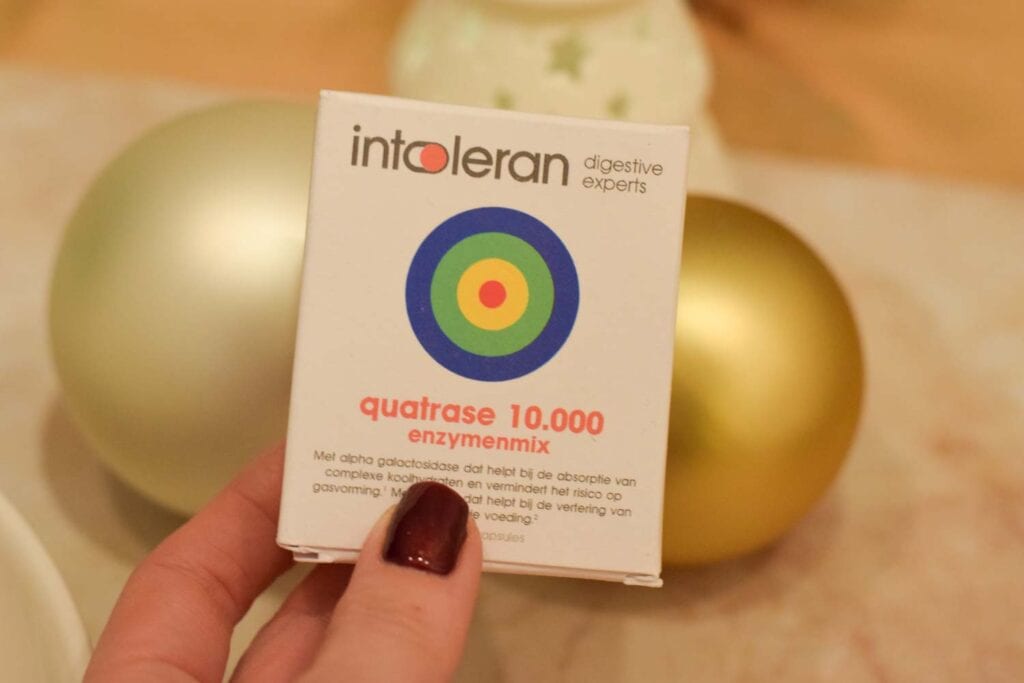
Intolerant to several FODMAPs?
Do you know that you react to several FODMAP groups? Then the supplement Quatrase 10.000 can be helpful to you.
Quatrase 10.000 is an enzyme formula to support the digestion of the most common gut symptom triggers like FODMAPs.
The product helps to reduce IBS complaints, occasional gas, bloating, and discomfort associated with FODMAP intolerance*
This supplement contains four different enzymes to aid the digestion of several FODMAPs: lactose, fructose, fructans, and galactans (not for polyols, such as mannitol and sorbitol).
Just like Fibractase, it contains the enzyme alpha-galactosidase.
Next to that, it contains the enzymes Xylose Isomerase, lactase, and Invertase.
I use this supplement when I eat something that contains lactose next to onion or garlic. Or for example when I think a meal also contains something high in fructose.
If you want to read more about this supplement, then you can also read my blog about Quatrase.
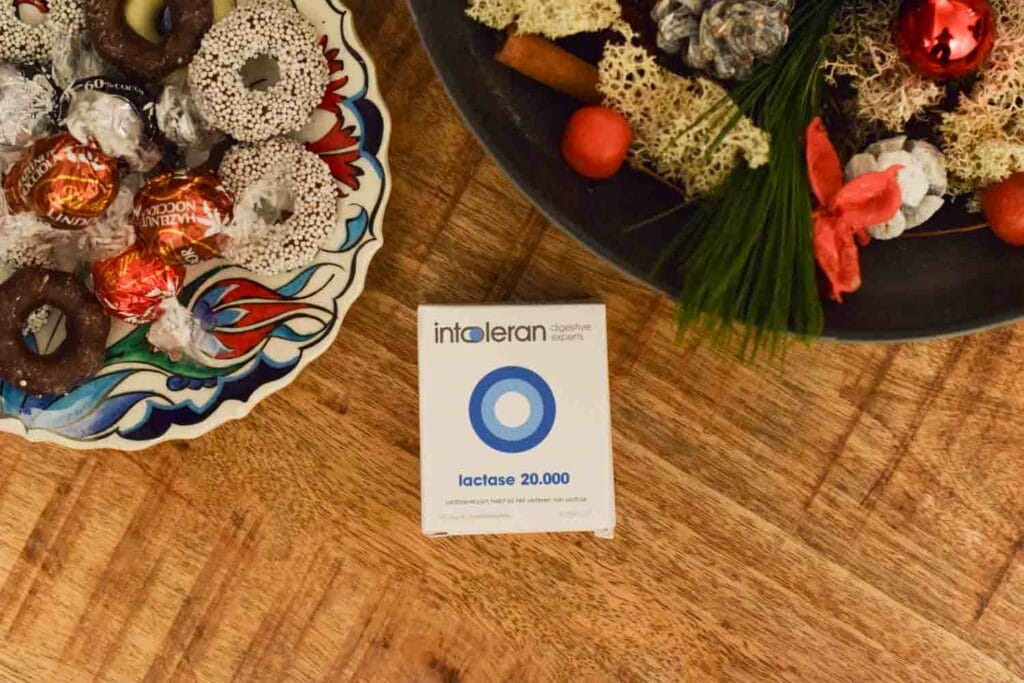
Intolerance to lactose
I have a lactose intolerance and I also regularly eat things that contain lactose, but that do not contain any other FODMAPs that I react to.
For example, a cappuccino that I drink outside the house. Then I use lactase enzymes, also from Intoleran.
They have many choices and strengths in this regard. For example, lactase 20,000, is their highest dose lactase tablet.
But also tablets and capsules for when you take smaller amounts of lactose, for example with a strength of 10,000 or 2,500.
There are also useful lactase drops that you can add to non-acidic milk products to make them low in lactose.
These supplements also have a holiday discount of 15% at the moment.
If you want to know more about this, you can also read my extensive blog about lactase supplements.
The Fibractase, Quatrase and Lactase supplements from Intoleran have been FODMAP-certified by Monash University and can also be found in the Monash FODMAP app.

Eating out without digestive issues
These supplements help me enormously to have fewer stomach problems during all kinds of parties and dinners.
It gives me just a few more options and the opportunity to sometimes eat with my friends and family a little more than I would otherwise.
That’s why I’m very happy that these supplements are available!
Have you ever tried any of these supplements? And how was your experience?
*These statements have not been evaluated by the Food and Drug Administration. This product is not intended to diagnose, treat, cure, or prevent any disease.

2 Comments
I am so grateful for your emails! I have been hospitalized twice with diverticulitis starting with long covid. The fodmap diet has been so helpful for me. Your recipes are good and fun to have on hand! I’m becoming more confident eating out and with friends. It’s so freeing! Thank you!
You’re welcome! I am happy that my emails have been helpful and that the diet works for you. I hope you’ll continue to feel better!